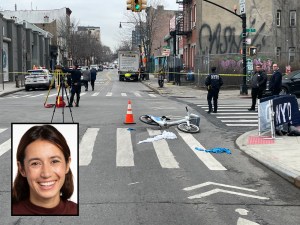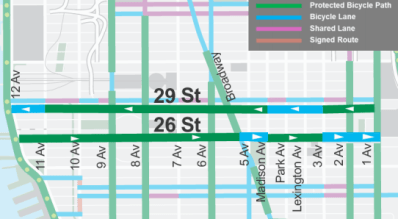Eyes on the Street: City Debuts ‘Double-Lane’ Protected Bike Lane on Four Blocks of Ninth Avenue

City cyclists have more than a passing acquaintance with passing — and the Department of Transportation is finally catching up.
DOT crews laid down four blocks of “double-lane” protected bike lane on Ninth Avenue in Manhattan this week — debuting a “passing lane” design officials plan to rollout later this year at locations across the city.
DOT planners will study the four blocks of double-lane bike lanes — from 17th Street to 21st Street — to determine where else to install the treatment, officials said.
“Wider bike lanes can make cycling more comfortable and social, encouraging the amazing growth we’ve seen in cycling and e-micromobility use,” Transportation Commissioner Ydanis Rodriguez said in a statement.
“DOT took advantage of a recent resurfacing of Manhattan’s Ninth Avenue to try out this first-of-its-kind ‘double-lane’ design before we incorporate similar wider bike lanes into projects beginning this year.”
City Hall teased new bike lane designs in a report on e-bike safety released in March. The “Charge Safe, Ride Safe” plan suggested that DOT was mulling wider bike lanes along with “passing zones, bicycle speed signal timing progressions, bike boulevards, improved curbside policies to reduce double parking, added bike parking for different uses, and cargo bike loading zones.”
On Ninth Avenue, DOT replaced its original 2008 design — a single six-foot bike lane flanked by two feet buffers on either side — with a six-foot bike lane alongside a four-foot passing lane. The design retained an eight-foot “door zone” buffer between the bike lane and parked cars:
DOT planners don’t have to look hard for ideas for how to make room for the growth of two-wheeled travel. A report released in February by the National Association of City Transportation Officials laid out design guidelines for bike paths in the era of many micro-mobility devices — recommending wider lanes as well as “maneuverable space at intersections” and signage that “makes the best place to ride obvious.”
A typical bike requires three feet of passing space, while cargo bikes require 3.5 feet, according to NACTO’s guidelines.

Editor’s note: The Department of Transportation informed Streetsblog after publication that city planners expanded the pilot from two blocks to four. This story has been updated accordingly.

